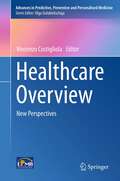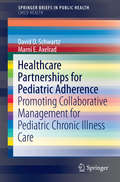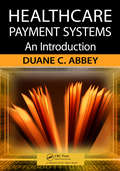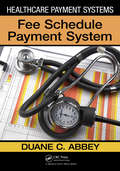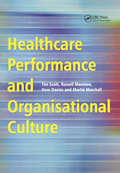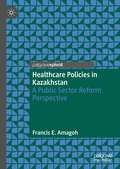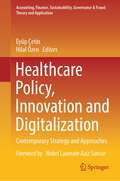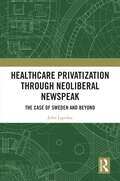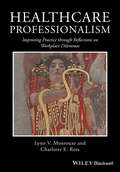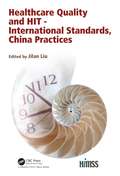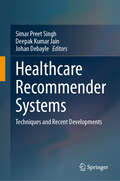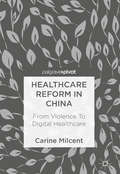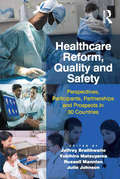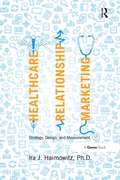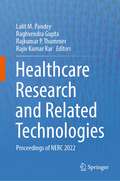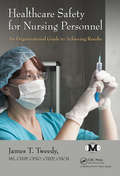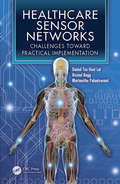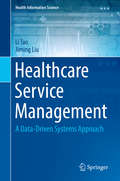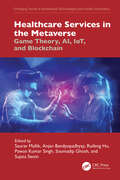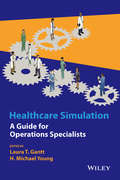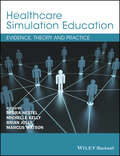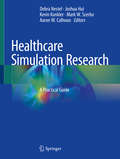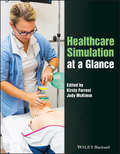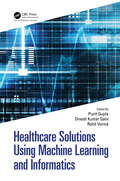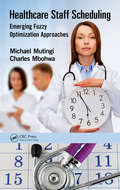- Table View
- List View
Healthcare Overview
by Vincenzo CostigliolaIn healthcare, the realisation of an optimistic prognosis against pessimistic ones depends on current innovations in diagnostic and cost-effective treatment approaches being widely adopted in clinical practice. Utilisation of advanced early and predictive diagnostics, targeted prevention and personalised medical approaches could enable the elderly subpopulation to reach the 100-year age limit in good physical and mental health, as actively contributing members of society. This task requires intelligent political regulations and creation of new guidelines to advance current healthcare systems. In this book, we will collect contributions from several geopolitical regions of Europe, Asia and USA that provide expert opinion on healthcare organisation and outlook as well as economical aspects of personalised medicine.
Healthcare Partnerships for Pediatric Adherence
by David D. Schwartz Marni E. AxelradThis timely professional reference and educational resource applies current concepts of pediatric adherence to medical treatment to create a model for a family-centered, collaborative approach to managing chronic illness. At its core are the latest findings on adherence: the factors that encourage it, the barriers that derail it, and the most effective interventions for its improvement. The book's developmental lens highlights how adherence waxes and wanes across different stages of childhood and adolescence, and specialized chapters analyze social realities exacerbating adherence problems. And its end product is a framework for how patients, parents/caregivers, and providers can work together effectively for improved adherence and optimum outcomes. Included in the coverage: The scope and impact of nonadherence. Poverty, stress, and chronic illness management. Racial/ethnic health disparities and adherence. Reconsidering the idea of self-management. · Screening for nonadherence in pediatric patients. · A comprehensive behavioral health system for identifying and treating nonadherence. Healthcare Partnerships for Pediatric Adherence offers relevant contemporary perspective for pediatricians looking for new ways to reduce treatment failure, improve support to patients and their families, and promote patient involvement in their own care.
Healthcare Payment Systems: An Introduction
by Duane C. AbbeyHealthcare Payment Systems: An Introduction provides a complete introduction to healthcare payment systems. Written by Duane Abbey, one of the nation‘s leading experts and most sought out consultants on payment systems, this volume makes the monumental task of medical reimbursement approachable and manageable. Covering the fundamentals and terminology needed to understand this discipline, and the strategies needed to master it, Dr. Abbey will help you begin to develop the solid core of skills and knowledge needed to confidently approach payment systems as tools to use rather than hazards to avoid -- tools that will lead to improved revenue cycles and higher levels of profitability.
Healthcare Payment Systems: Fee Schedule Payment Systems
by Duane C. AbbeyFor healthcare providers and patients alike, the ways of private third-party payer payment systems can be mysterious and oftentimes quite frustrating. Payment for hospital, nursing, or homecare services can be subject to a variety of payment systems including cost-based and charge-based or those with payments that are determined in advance. Knowing
Healthcare Performance and Organisational Culture
by Tim Scott Russell Mannion Huw Davies Martin MarshallPeople from different cultural backgrounds prefer adhering to their own religious beliefs which could restrict treatment options leading to the detriment of health especially if it involves the health of a disabled child. This comprehensive but concise work highlights the problems faced in managing the care of disabled children from different cultural backgrounds. It examines the problems inherent in the medical social and educational management of children with developmental disability in populations whose value systems differ from other cultures. In particular it considers how care may be varied according to cultural background without compromising its quality. The book is of immense value for all healthcare and social care professionals policy makers and shapers patient organisations and those with an interest in medical ethics.
Healthcare Policies in Kazakhstan: A Public Sector Reform Perspective
by Francis E. AmagohThis book is the first of its kind about healthcare reform efforts in Kazakhstan since its independence within the context of the public sector reform movement. The book provides a brief background of Kazakhstan and its Soviet legacy and the country’s efforts to modernize the health system, before creating an overview of the existing system, the reforms since independence, and the future of healthcare in Kazakhstan. This book will be of interest to policymakers, analysts, and development economists.
Healthcare Policy, Innovation and Digitalization: Contemporary Strategy and Approaches (Accounting, Finance, Sustainability, Governance & Fraud: Theory and Application)
by Eyüp Çetin Hilal ÖzenThis book takes a deep look at healthcare in today’s post-pandemic world. It combines both theory and application to reflect a new era for healthcare. The need for innovation, digitalization, and enhanced policies in healthcare has never been greater than it is today. Taking this need into consideration, this book offers a multidisciplinary approach to healthcare, in both managerial and clinical views. Since the book combines both qualitative and quantitative studies about healthcare, readers will receive a broad view of healthcare issues and policies in today’s world.
Healthcare Privatization through Neoliberal Newspeak: The Case of Sweden and Beyond
by John LapidusUsing Sweden as its starting point, this insightful book examines how universal health systems around the world are gradually being eroded by the privatization of provision and funding.This book argues that the influence of commercial interests creates two parallel systems, fatally undermining the principle that public healthcare should be equally available to all citizens. Significantly, it highlights how the language used to describe these neoliberal developments essentially disguises their broader impact, a type of newspeak that frames privatization as a logical response to the pressures faced by welfare states. Each chapter focuses on a different actor, from private healthcare providers to insurance companies, employers, and unions, illustrating the creeping commodification of healthcare not only in Sweden but also internationally.Erudite and incisive, this will be fascinating reading for scholars and students across public health, political science, and beyond.
Healthcare Professionalism: Improving Practice through Reflections on Workplace Dilemmas
by Charlotte E. Rees Lynn V. MonrouxeHealthcare Professionalism: Improving Practice through Reflections on Workplace Dilemmas provides the tools and resources to help raise professional standards within the healthcare system. Taking an evidence and case-based approach to understanding professional dilemmas in healthcare, this book examines principles such as applying professional and ethical guidance in practice, as well as raising concerns and making decisions when faced with complex issues that often have no absolute right answer. Key features include: Real-life dilemmas as narrated by hundreds of healthcare students globally A wide range of professionalism and inter-professionalism related topics Information based on the latest international evidence Using personal incident narratives to illustrate these dilemmas, as well as regulatory body professionalism standards, Healthcare Professionalism is an invaluable resource for students, healthcare professionals and educators as they explore their own professional codes of behaviour.
Healthcare Quality and HIT - International Standards, China Practices (HIMSS Book Series)
by Jilan Liu Jiaxin Wang Xinyue Du Zhuo Li Mu Tian Xiangjuan KongHow Chinese hospitals have been growing and adopting international standards such as JCI and HIMSS EMRAM to fuel their advancements is not well-known to the western world. In this book, Jilan Liu, as former Principal Consultant of JCI and current Chief Executive Officer for HIMSS Greater China, presents a selection of case examples written by Chinese hospital executives and staff showcasing first-hand experiences and insights into how the leading healthcare organizations grow and continue their success in China. The case examples include Chinese hospitals who have participated in JCI accreditation and/or HIMSS EMRAM. These hospitals represent the new wave of organizations adopting international standards while accommodating the unique conditions of China.
Healthcare Recommender Systems: Techniques and Recent Developments
by Simar Preet Singh Johan Debayle Deepak Kumar JainThe book explores the complete system perspective, underlying theories, modelling, and the applications of pattern recognition in Healthcare Recommender System. Considering the interest of researchers and academicians, editors here aim to present this book in a multidimensional perspective that will be covering Healthcare Recommender Systems in depth, considering pattern recognition techniques using amalgamation of emerging technologies. It aims to cover all topics ranging from discussion of recommender system to efficient management to recent research challenges and issues. Editors aim to present the book in a self-sufficient manner and in order to achieve this, the book has been organized into various chapters. The prime focus of the book is to explore the various issues, challenges, and research directions of pattern recognition in Healthcare Recommender Systems. The table of contents is designed in a manner so as to provide the reader with a broad list of its applications. Additionally, the book addresses the transformations in the area of Healthcare Recommender Systems. Thus, the book plans to discuss the recent research trends and advanced topics in the field of healthcare automation system which will be of interest to industry experts, academicians and researchers working in this area. Hence, the editors aim is to cover diversity in the domain while achieving completeness.
Healthcare Reform in China: From Violence To Digital Healthcare
by Carine MilcentHow efficient is the Chinese healthcare system? Milcent examines the medication market in China against the global picture of healthcare organization, and how public healthcare insurance plans have been implemented in recent years, as well as reforms to tackle hospital inefficiency. Healthcare reforms, demographic changes and an increase in wealth inequity have altered healthcare preferences, which need to be addressed. Significantly, the patient–medical staff relationship is analysed, with new proposals for different lines of communication. Milcent puts forward digital healthcare in China as a tool to solve inefficiency and rising tensions, and generate profit. Where China is leading in the digitalization of healthcare, other countries can learn important lessons. Chinese social models are also put into context with respect to current reforms and experimentation.
Healthcare Reform, Quality and Safety: Perspectives, Participants, Partnerships and Prospects in 30 Countries
by Julie Johnson Jeffrey Braithwaite Yukihiro MatsuyamaThis book offers a global perspective on healthcare reform and its relationship with efforts to improve quality and safety. It looks at the ways reforms have developed in 30 countries, and specifically the impact national reform initiatives have had on the quality and safety of care. It explores how reforms drive quality and safety improvement, and equally how they act to negate such goals. Every country included in this book is involved in a reform and improvement process, but each takes place in a particular social, cultural, economic and developmental context, leading to differing emphases and varied progress. Methods for tackling common problems - financing, efficiencies, effectiveness, evidence-based practice, institutional reforms, quality improvement, and patient safety initiatives - also differ. Representatives from each nation provide a chapter to convey their own situation. The editors draw a conclusion from these numerous contributions and synthesize the themes emerging into a coherent ’lessons learned’ summary that delivers value to the numerous stakeholders. Healthcare Reform, Quality and Safety forms a compendium of the current ’state of the art’ in global healthcare reform. This is the first book of its type, and offers a unique opportunity for cross-fertilization of ideas to the mutual benefit of countries involved in the project. The content will be of interest to governments, policymakers, managers and leaders, clinicians, teaching academics, researchers and students.
Healthcare Relationship Marketing: Strategy, Design and Measurement
by Ira J. HaimowitzIn recent years there have been dramatic changes in the pharmaceutical promotional landscape, affecting both consumers and healthcare professionals. One consequence of these dynamics is the need for pharmaceutical companies to plan new kinds of dialogue and relationships with their stakeholders. The evolution has been from mass-channel "push" marketing to two-way, multi-channel relationship marketing. Targeted Emails, webinars, mobile messages, and social networks are expanding in usage. This book is a practical overview and resource guide for the design and measurement of pharmaceutical relationship marketing (RM) programs. There are descriptions of each aspect of pharmaceutical RM design and measurement, including a running case study with follow-up exercises. The author has also conducted interviews from several pharmaceutical marketing industry experts, each having 15 years or more of working healthcare RM knowledge, and each speaking on their specific specialities. For newcomers to healthcare marketing, this book can serve as a foundation and introduction that provides framework, details, and examples of both relationship marketing designs and associated measurement disciplines. Healthcare Relationship Marketing will also be valuable to readers currently working in pharmaceutical marketing or sales who may not have exposure to the particular disciplines of relationship marketing and direct response measurement and optimization. Even for the experienced practitioner this will serve as a convenient reference that pulls together all of the program components and measurement frameworks within a single book. This book may also serve as a textbook within a university course in marketing, or a pharmaceutical business program.
Healthcare Research and Related Technologies: Proceedings of NERC 2022
by Raghvendra Gupta Lalit M. Pandey Rajkumar P. Thummer Rajiv Kumar KarThis book presents select proceedings of the North East Research Conclave (NERC 2022). The book mainly covers research related to healthcare and related technologies. It includes broad bioengineering applications divided into four parts, namely, biomaterials and tissue engineering, biomedical science and engineering, drug delivery and therapeutics and cell and molecular biology. The book encompasses the latest research and advancements in the field of healthcare and related technologies. This book also describes a few studies based on computer simulations in bioengineering. In addition, the fundamental and basic aspects are also discussed for the better understanding of readers. The book can be a valuable reference for beginners, researchers and professionals interested in the field of healthcare and related technologies.
Healthcare Safety for Nursing Personnel: An Organizational Guide to Achieving Results
by James T. TweedyNursing personnel play an integral role in healthcare and medical delivery organizations. Nurses not only work to keep patients safe, but must also contend with a number of safety and health risks. Illustrating the occupational risks nurses face, Healthcare Safety for Nursing Personnel: An Organizational Guide to Achieving Results addresses healthc
Healthcare Sensor Networks: Challenges Toward Practical Implementation
by Marimuthu Palaniswami Daniel Tze Huei Lai Rezaul BeggHealthcare sensor networks (HSNs) now offer the possibility to continuously monitor human activity and physiological signals in a mobile environment. Such sensor networks may be able to reduce the strain on the present healthcare workforce by providing new autonomous monitoring services ranging from simple user-reminder systems to more advanced mon
Healthcare Service Management: A Data-Driven Systems Approach (Health Information Science)
by Jiming Liu Li TaoHealthcare service systems are of profound importance in promoting the public health and wellness of people. This book introduces a data-driven complex systems modeling approach (D2CSM) to systematically understand and improve the essence of healthcare service systems. In particular, this data-driven approach provides new perspectives on health service performance by unveiling the causes for service disparity, such as spatio-temporal variations in wait times across different hospitals.The approach integrates four methods -- Structural Equation Modeling (SEM)-based analysis; integrated projection; service management strategy design and evaluation; and behavior-based autonomy-oriented modeling -- to address respective challenges encountered in performing data analytics and modeling studies on healthcare services. The thrust and uniqueness of this approach lies in the following aspects: Ability to explore underlying complex relationships between observed or latent impact factors and service performance.Ability to predict the changes and demonstrate the corresponding dynamics of service utilization and service performance.Ability to strategically manage service resources with the adaptation of unpredictable patient arrivals.Ability to figure out the working mechanisms that account for certain spatio-temporal patterns of service utilization and performance. To show the practical effectiveness of the proposed systematic approach, this book provides a series of pilot studies within the context of cardiac care in Ontario, Canada. The exemplified studies have unveiled some novel findings, e.g., (1) service accessibility and education may relieve the pressure of population size on service utilization; (2) functionally coupled units may have a certain cross-unit wait-time relationship potentially because of a delay cascade phenomena; (3) strategically allocating time blocks in operating rooms (ORs) based on a feedback mechanism may benefit OR utilization; (4) patients’ and hospitals’ autonomous behavior, and their interactions via wait times may bear the responsible for the emergence of spatio-temporal patterns observed in the real-world cardiac care system. Furthermore, this book presents an intelligent healthcare decision support (iHDS) system, an integrated architecture for implementing the data-driven complex systems modeling approach to developing, analyzing, investigating, supporting and advising healthcare related decisions. In summary, this book provides a data-driven systematic approach for addressing practical decision-support problems confronted in healthcare service management. This approach will provide policy makers, researchers, and practitioners with a practically useful way for examining service utilization and service performance in various ``what-if" scenarios, inspiring the design of effectiveness resource-allocation strategies, and deepening the understanding of the nature of complex healthcare service systems.
Healthcare Services in the Metaverse: Game Theory, AI, IoT, and Blockchain (Emerging Trends in Biomedical Technologies and Health informatics)
by Pawan Kumar Singh Saurav Mallik Anjan Bandyopadhyay Ruifeng Hu Soumadip Ghosh Sujata SwainThis book focuses on game theory approaches utilized on various domains viz., IoT, blockchain and their applications to biomedical and healthcare services. The book bridges the gap between radiologists and Artificial Intelligence (AI)-driven automated systems by investigating various techniques such as game theoretic approach, blockchain technology basically utilized for security, and IoT applied on metaverse. Healthcare Services in the Metaverse: Game Theory, AI, IoT, and Blockchain, identifies the potential areas where game theory and block chain techniques can be harnessed in the metaverse. The book discusses the integration of virtual reality (VR) with augmented reality to identify the new emerging techniques in healthcare to metaverse, where doctors and/or patients can see any kind of operation in the VR metaverse. The authors use game theoretical and blockchain approaches to understand healthcare issues, with the aim of utilizing different technologies of metaverse platform for health informatics. This book is written to help healthcare practitioners and individuals across academia and research, as well as for those who work in biomedical, Internet of Things (IoT), Artificial Intelligence (AI), metaverse, VR, blockchain, and related technologies.
Healthcare Simulation
by H. Michael Young Laura T. GanttA focused guide for healthcare simulation operations in education and training With the growing use of simulation within the field of healthcare, Healthcare Simulation: A Guide for Operations Specialists provides a much needed resource for developing the roles and responsibilities of simulation operations specialists. The book illustrates the current state and evolution of the simulation professional workforce and discusses the topics necessary for the development of this pivotal role. The book promotes the value of simulation in healthcare and its associated outcomes while clarifying the operational requirements of successful simulations. Featuring numerous contributions from international experts, consultants, and specialists, Healthcare Simulation: A Guide for Operations Specialists presents advances in healthcare simulation techniques and also features: Coverage of the best practices and available technologies for healthcare simulation operations specialists within healthcare education, training, and assessment Interdisciplinary, practical examples throughout to help readers better understand the presented material An overview of the many facets of day-to-day operations within a healthcare simulation lab Discussions regarding the concurrent need for understanding proper patient care that accompanies the human-to-machine interface in patient simulation Healthcare Simulation: A Guide for Operations Specialists is an excellent reference for healthcare simulation professionals including administrators, medical directors, managers, simulation technologists, faculty members, and educators in academic and healthcare settings. The book is also a useful supplementary textbook for graduate-level courses related to simulation and certificate programs in simulation education and simulation operations.
Healthcare Simulation Education: Evidence, Theory and Practice
by Michelle Kelly Debra Nestel Brian Jolly Marcus WatsonWritten by a leading team from the Australian Society for Simulation in Healthcare (ASSH), Simulation Australasia, Healthcare Simulation Education is a new resource for a rapidly expanding professional healthcare simulation community. Designed as a core reference for educators who use simulation as an educational method, it outlines theory, evidence and research relevant to healthcare simulation. Containing examples of innovations from around the world, the book offers opportunities to make clear connections between the underlying rationale for the use of simulation, and what this looks like in practice. Healthcare Simulation Education: Helps readers gain a systematic understanding of theory and application of simulation Facilitates access to high quality resources to support healthcare simulation education and research Edited by a leading team from the Australian Society for Simulation in Healthcare (ASSH), the leading body for healthcare simulation in Australia Contains information on educational theory, the elements of simulation practice and contemporary issues in simulation An important text in healthcare literature and practice, Healthcare Simulation Education provides a unique cross-disciplinary overview of an innovative subject area, and is ideal for medical, nursing and allied health educators, policy makers and researchers.
Healthcare Simulation Research: A Practical Guide
by Debra Nestel Mark W. Scerbo Joshua Hui Kevin Kunkler Aaron W. CalhounThis book provides readers with a detailed orientation to healthcare simulation research, aiming to provide descriptive and illustrative accounts of healthcare simulation research (HSR). Written by leaders in the field, chapter discussions draw on the experiences of the editors and their international network of research colleagues. This seven-section practical guide begins with an introduction to the field by relaying the key components of HSR. Sections two, three, four, and five then cover various topics relating to research literature, methods for data integration, and qualitative and quantitative approaches. Finally, the book closes with discussions of professional practices in HSR, as well as helpful tips and case studies.Healthcare Simulation Research: A Practical Guide is an indispensable reference for scholars, medical professionals and anyone interested in undertaking HSR.
Healthcare Simulation at a Glance (At a Glance)
by Kirsty Forrest Judy McKimmHealthcare Simulation at a Glance provides an accessible overview to key educational aspects of simulation education, and how they relate to simulation in clinical practice and university based education. <p><p> Structured into five sections, it begins with an introduction to simulation before moving on to focusing on the learning theories that underpins the approaches, and how to embed simulation into a programme. Sections three and four look at the technical and non-technical features of simulation in various contexts, and how it can be used in assessment and providing feedback to health professionals. The last section considers how simulation educators can develop their own practice through different activities and approaches. <p> Using case examples and practical tips, Healthcare Simulation at a Glance offers structure and a framework applicable to a complex area, and is ideal for those new to using simulation in education, as well as experienced academics.
Healthcare Solutions Using Machine Learning and Informatics
by Rohit Verma Punit Gupta Dinesh Kumar SainiHealthcare Solutions Using Machine Learning and Informatics covers novel and innovative solutions for healthcare that apply machine learning and biomedical informatics technology. The healthcare sector is one of the most critical in society. This book presents a series of artificial intelligence, machine learning, and intelligent IoT-based solutions for medical image analysis, medical big-data processing, and disease predictions. Machine learning and artificial intelligence use cases in healthcare presented in the book give researchers, practitioners, and students a wide range of practical examples of cross-domain convergence. The wide variety of topics covered include: Artificial Intelligence in healthcare Machine learning solutions for such disease as diabetes, arthritis, cardiovascular disease, and COVID-19 Big data analytics solutions for healthcare data processing Reliable biomedical applications using AI models Intelligent IoT in healthcare The book explains fundamental concepts as well as the advanced use cases, illustrating how to apply emerging technologies such as machine learning, AI models, and data informatics into practice to tackle challenges in the field of healthcare with real-world scenarios. Chapters contributed by noted academicians and professionals examine various solutions, frameworks, applications, case studies, and best practices in the healthcare domain.
Healthcare Staff Scheduling: Emerging Fuzzy Optimization Approaches
by Charles Mbohwa Michael MutingiHealthcare operations, in hospitals and home healthcare settings, are inundated with complex fuzzy features that impose difficulties in the creation of work schedules. This book presents in-depth research on emerging approaches to healthcare staff scheduling. It starts by reviewing the key issues and challenges inherent in staff scheduling, along with the basic concepts of fuzzy set theory. Examining cutting-edge research applications, it details fuzzy optimization algorithms derived from biologically inspired approaches and fuzzy theory. Facilitating a practical and in-depth understanding of modern fuzzy metaheuristic optimization approaches, the book presents recent research on multi-criteria algorithms and their applications in healthcare operations, particularly staff scheduling.
